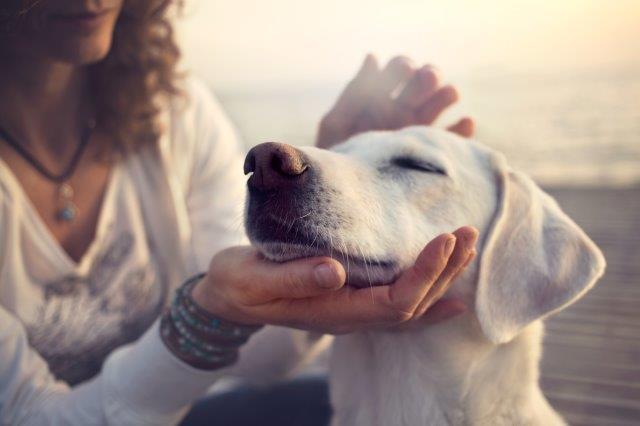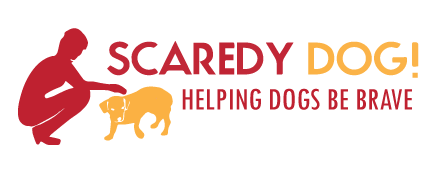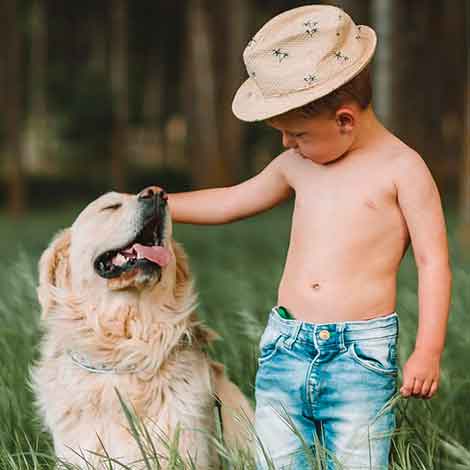Teaching Your Dog “Ok, I’m ready!”

Will a training clicker help my Scaredy Dog?
Many scaredy dogs are easily startled and flinch away when they are touched unexpectedly. This can happen even if they know and trust the person touching them. This is especially troublesome at the vet and grooming salon where they are touched all over their body whether they like it or not. Giving your dog the choice whether to participate or not gives your dog more control over what happens to him, and therefore helps your dog relax in a scary and potentially painful situation.
There are many different ways to teach your dog to give you permission to proceed (using a chin rest, a nose touch, or teaching the Bucket Game by Chirag Patel, etc), but probably the easiest is to use the cue Watch Me. This is great because it’s often the very first cue taught when beginning clicker training anyway, so the dog doesn’t need any kind of formal training background in order to understand this. If your dog is already clicker trained, you’re already well prepared and this shouldn’t take long to master. If your dog is not yet clicker trained, this is a great place to start!
Teaching your dog
Step 1:
Load the clicker by clicking it and giving your dog a treat. Do this several times and then stop. Your dog will most likely look up at you to wonder why you stopped giving him treats. As soon as he looks up at you, click the clicker and give your dog a treat. From then on, wait until your dog looks at you to click and treat him.
Step 2:
Add the cue Watch Me or Look At Me by saying your phrase just before he looks up at you, then click and treat when he does. Timing here is very important – you have to watch your dog carefully to say the phrase the instant before he looks at you, and then you have to click the clicker the very instant your dog makes eye contact. Say the cue just before he looks at you several times, and then say to cue to prompt him to look up at you and click and give him lots of treats when he does. Repeat this several times.
Step 3:
You should now be able to prompt your dog to look at you with the cue Watch Me or Look At Me. At this point, we’re going to work on duration. Say the cue, but make your dog hold eye contact for a split second before you click and give him the treat. Do this several times, and then build up so he holds eye contact with you for a full second before you click and treat. Keep building this up until he can hold eye contact for several seconds at a time.
Step 4:
Now we’re going to teach your dog how to say no. Give the cue and have your dog hold eye contact with you and while he does, you can start moving. Start with small movements, like wiggling your fingers. If your dog breaks eye contact to see what you’re doing, stop moving immediately and your dog gets no treat. If you dog holds eye contact while you wiggle your fingers, click and treat him. Do this repeatedly until your dog can hold eye contact with you despite your wiggling fingers. Next, you’ll move on to slowly moving your hands.
If your dog breaks eye contact at any time, stop whatever you’re doing. Eventually your dog will understand that if he’s uncomfortable with anything you’re doing, he has the power to make you stop just by breaking eye contact to see what you’re doing. If your dog keeps eye contact, he’s ready and comfortable enough for you to continue.
Start with wiggling fingers and slowly moving your hands, and then you can build up from there. Lift your hands up towards his face and click and treat if he keeps eye contact. You can practice touching him and clicking and treating him when he keeps eye contact. You can also sit and have him hold eye contact with you while a second person moves around touching him. This is great practice for the vet’s office because you can have your dog look at you while the vet examines him. Giving your dog the power to say “Hold on, I’m not ready” or “Ok, go ahead” gives the dog a lot more power over what’s happening to him. That power makes the vet’s office and groomer a lot less scary, as opposed to needing to be restrained.
Do you want to keep up with our training guides?
For more helpful tips on handling your scaredy dog, please take a look at our Training Guides. We also have our FAQ page and you can also find Scaredy Dog on Facebook.




